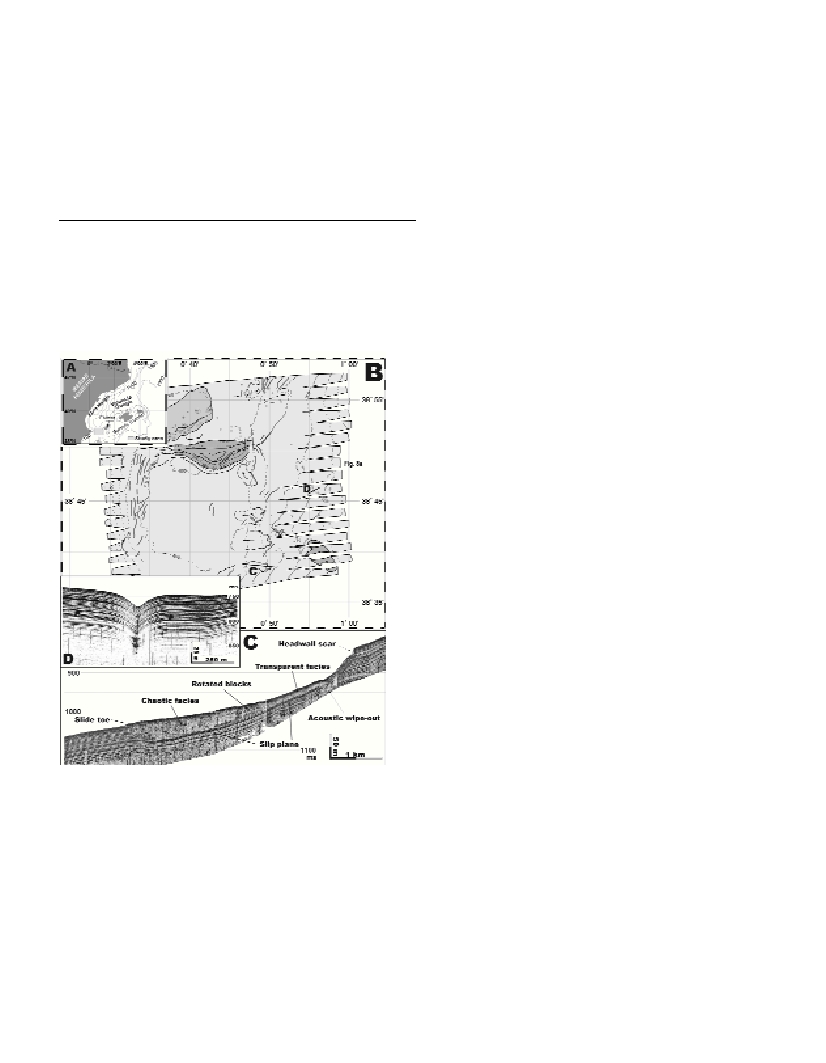Rapp. Comm. int. Mer Médit., 37,2004
43
SLIDES AND RELATED FLUID ESCAPE FEATURES IN THE EIVISSA CHANNEL,
WESTERN MEDITERRANEAN
G. Lastras
*
, M. Canals
GRC Geociències Marines, Universitat de Barcelona, Barcelona, Spain - * galderic@natura.geo.ub.es
Abstract
Four slides have been identified in the Balearic margin of the Eivissa Channel. They are easily recognizable in detailed swath bathymetry
maps and very-high resolution seismic re?ection profiles. The slides share the same slip plane, which corresponds to a continuous, high
amplitude re?ector. Headwall scars are related to pockmarks, which are also present further upslope on the Balearic margin of the Eivissa
Channel. Therefore, it can be stated that there is a link between ?uid escape features and destabilisation of the upper sediment layers.
Keywords: Submarine slides, pockmarks, ?uid escape, Eivissa Channel
The Eivissa Channel opens between Alacant, in the Iberian
Peninsula, to the west, and the island of Eivissa, to the east (Fig. 1A).
It has a slightly asymmetric saddle morphology, with the Iberian
margin steeper than the Balearic margin. The Eivissa Channel is
interrupted by a ca. 200 m high east-west trending seamount named
the “Xàbia Seamount”. Most of the fine sediment reaching the Eivissa
Channel is thought to come from the Iberian Peninsula, transported by
the southwards regional circulation along the Iberian margin.
Fig. 1. A. Location map of the study area. B. Interpretation of the swath
bathymetry data, showing the four slides in the Balearic margin, the
pockmarks (stars), and the Xàbia Seamount (dark grey). C. Seismic pro-
file across the Ana Slide, showing its characteristics and seismic facies.
D. Seismic profile across a pockmark. Black arrows show location of the
re?ector related to the slip plane of the slides.
Swath bathymetry data allowed to identify four headwall scars and
associated slide deposits, namely from south to north Ana, Joan, Nuna
and Jersi slides, which are roughly aligned along the 0º48’E meridian
on the Balearic margin ?anking the southern sector of the Eivissa
Channel (Fig. 1B). The Ana Slide, located at ~38º38’30”N at water
depths ranging from 635 m at the rim of the headwall scar to 815 m
at its toe, with a horseshoe shaped headwall scar up to 30 m high,
disturbs an area of 6 km
2
and involves 0.11 km
3
of sediment (Fig. 1C).
The Joan Slide, located approx. at 38º41’N from 600 to 870 m of
water depth and a headwall scar up to 10 m high, affects 16 km
2
of the
sea?oor. The Nuna Slide, located at ~38º43’30”N between 675 and
860 m of water depth, is the result of two events disturbing 10.3 km
2
of the sea?oor. It has a headwall scar of up to 20 m high. Finally, the
Jersi Slide displays a 15 m high headwall scar and covers 7.9 km
2
of
the sea?oor at ~38º47’30”N.
Very-high-resolution seismic re?ection profiles image these slides
as sediment bodies mostly made of transparent seismic facies
(Fig.1C). Chaotic facies are observed at the toe of some of the slides,
and blocks of coherent stratified facies embedded in the slide deposit
have been identified too. These profiles demonstrate that the four
slides share the same slip plane, which corresponds to a continuous,
high amplitude re?ector.
At a short distance from the Ana Slide headwall there is an acoustic
wipe-out (Fig. 1C). In plan view, the headwall is complicated by a
semi-circular embayment that could mark the location of a former
large pockmark. Acosta et al. (1) identified the pockmark field north
of Xàbia Seamount, in the northern Eivissa Channel region, but
additional pockmark fields and isolated pockmarks can be identified
south of the Xàbia Seamount, upslope the slides (Fig. 1B). These are
often aligned, ~100 m in diameter and ~15 m in depth. They are either
currently active or have been active in recent times. This is supported
by the lack of buried pockmarks in the profiles and by the fact that all
of them disturb not only the uppermost sediment layers but also the
sea?oor (Fig. 1D).
Since pockmarks are related to the headwall scars of some of the
slides, it can be stated that there is a link between ?uid escape features
and destabilisation of the upper sediment layers. The role of
pockmarks in favouring the triggering of the slides may be double.
Escaping ?uids forming the pockmarks may have been injected into
the common slip plane, thus increasing the pore pressure; and
pockmarks represent a discontinuity reducing the shear resistance
along the potential failure plane. The fact that all the slides in the
Eivissa Channel occupy the same stratigraphic position and share the
same slip plane could indicate that they occurred simultaneously
following a common triggering mechanism.
References
1-Acosta, J., Muñoz, A., Herranz, P., Palomo, C., Ballesteros, M.,
Vaquero, M., Uchupi, E., 2001. Pockmarks in the Ibiza Channel and
western end of the Balearic Promontory (western Mediterranean) revealed
by multibeam mapping. Geo-Mar. Lett., 21: 123-130.

